I am asking a question to a similar post posted up 2 years ago, with no full answer to it (subset of prcomp object in R). P.S. sorry for commenting on it for an answer..
Basically, my question is the same. I have generated a PCA table using prcomp that has 10000+ genes, and 1700+ cells, made up of 7 timepoints. Plotting all of them in a single file makes it difficult to see.
I would like to plot each timepoint separately, using the same PCA results table (ie without re-running prcomp).
Thanks Dean for giving me tips on posting. To think of a way to describe my dataset without actually loading it here, will take me a week I believe. I also tried the
dput(droplevels(head(object,2)))
option, but it was just too much info since I have such a large dataset. In short, it is a large matrix of single-cell dataset where people can commonly see on packages such as Seurat (https://satijalab.org/seurat/pbmc3k_tutorial_1_4.html). EDIT: I have posted a screenshot of a subset of my matrix here ( ).
).
Sorry I don't know how to re-create this or even export a text format.. But this is what I can provide: My TPM matrix has 16541 rows (defining genes), and 1798 columns (defining cells).
In it, I have "re-labelled" my columns based on timepoints, using codes such as:
D0<-c(colnames(TPM[,grep("20180419-24837-1-*", colnames(TPM))])) #D0: 286 cells
D7<-c(colnames(TPM[,grep("20180419-24837-2-*", colnames(TPM))])) #D7: 237 cells
D10<-c(colnames(TPM[,grep("20180419-24947-5-*", colnames(TPM))])) #D10: 304 cells
...... and I continued to label each timepoint.
Each timepoint was also given a specific colour.
rc<-rep("white", ncol(TPM))
rc<-[,grep("20180419-24837-1-*", colnames(TPM))]= "magenta"
...... and I continued to give colour to each timepoint.
I performed a PCA using this code:
pcaRes<-prcomp(t(log(TPM+1)), center= TRUE, scale. = TRUE)
Then I proceeded to plot a PCA plot using:
plot(pcaRes$x[,1], pcaRes$x[,2], xlab="PC1", ylab="PC2",
cex=1.0, col= rc, pch=16, main="")
Then I when I wanted to plot a PCA plot only with D0, using the same PCA output (pcaRes).. This is where I am stuck.
P.S. If anyone else has an easier way of advising how to input an example data here from my large matrix, I welcome any help. Thanks so much! Sorry I am very new in bioinformatics.

